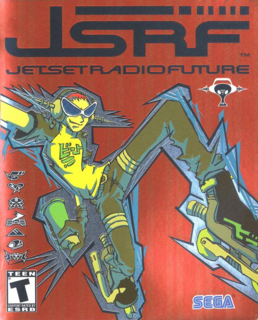The Future is Bright
JSRF's formula is very similar to it's predecessor, albeit somewhat more heavily story-driven. Once again, you find yourself in charge of a streetwise gang of kids who call themselves the G.G.'s, and your objectives frequently involve spraying graffiti tags over the tags of rival gangs, and recruiting other urban denizens, thus expanding your group's roster and territory. In addition to the occasional rival-gang showdown, you'll frequently be assailed by the Rokkaku Police, a "Big Brother" type group of fascist corporate goons who essentially control the cities of futuristic Japan. Using "graffiti souls" and the "Soul of the Street" (read: spraypaint) your ever expanding group of freedom fighters contend with the Rokkaku Police by leaving their wild paint tags on public property, including busses, buildings, and Rokkaku Police "Terror Drones."
The game play itself has been altered somewhat from the Dreamcast original. Your character's speed is increased, and their movements, while occasionally jerky, are much more maneuverable than in the first game. Also, the "dash" function has been replaced by a jet-powered speed boost, which depletes your spray cans by 10 and sends your character flying forward with a burst of intense speed, but due to your total lack of control in such a state you'll soon learn that precise timing is essential. The most significant change to the gameplay is the way you make your tags. While in the first game, spraying paint involved moving the thumb pad in directions as they were displayed on the screen, (somewhat a DDR-styled minigame) Future simply requires holding down the R trigger as your approach a paintable area. The lack of concentration on painting gives way to an enhanced trick system, which lets the player flip, spin and do other tricks while grinding. While regulating your speed as you pass a cluster of taggable spots requires some skill (as well a bit of luck) some might not appreciate this game's increased emphasis on action.
The game's trademark cel-shaded art style is back in full force, and it looks better and smoother than ever on the Xbox. The motion blur effects used along with the already great-looking cell shaded art style manage to convey an amazing sense of speed when you speed boost, and the cartoon-like effects (such as stars swimming around the head of a dazed enemy) fit in nicely with the art style, and result in a slick and expressive manga-like look.
The audio in this game was definitely selected with the target audience in mind. JSRF caters to an obscure, cult audience, so naturally there is an array of obscure, cult music playing in the background. Many tracks are simply remixes of those heard in the first game, but a few new songs can be heard, from artists new and old to the series. Some of the louder and wilder songs (a perfect example being the violently noisy "Birthday") will most likely grate on the nerves of some, but that small niche of folks at whom this game was squarely aimed will eat it all up.
Jet Set Radio Future is definitely has a lot of personality, especially for an Xbox title (and a relatively early one at that) and is easily recommendable to fans of the original. Newcomers looking for something with quirk value, or just in need of a cool little addition to their Xbox library should also look no further than JSRF, but those who don't have much of a taste for the obscure should beware.

